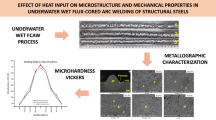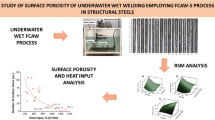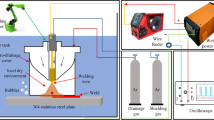Abstract
Flux-cored arc welding (FCAW) of duplex stainless steels has been widely used in offshore engineering, nuclear power engineering, and petroleum pipe lines. But underwater wet welding repair technology is still impossible for avoiding pore defects in welds. To study how pores perform in underwater wet welds, underwater wet flux-cored arc welding of S32101 duplex stainless steel was carried out in a hyperbaric chamber. The evolution of porosity and microstructure with welding parameters in 20 and 60 m water depth was analyzed for comparison. The relationship between porosity and austenite morphology in microstructures was discussed. Decreased welding parameters can increase the cooling rate. As a result, the ferrite to austenite transformation can be promoted and the resultant microstructures can be refined. Lower welding speed prolongs the high-temperature retention time, which is helpful to gas escaping from the molten pool. As a result, the porosity of the welds decreases. Reduced welding voltage with finer microstructure prevents the porosity in both water depths. It was found that the coarser the austenite microstructure was, the higher the porosity was. Additionally, the welds conducted with bigger welding current in 20 m water depth have lower porosity, the same as the welding speed, while the situation is reversed in 60 m water depth for a coarser austenite microstructure.








Similar content being viewed by others
References
N. Guo, M. Wang, Y. Du, W. Guo, J. Feng, Metal transfer in underwater flux-cored wire wet welding at shallow water depth. Mater. Lett. 144, 90–92 (2015)
D. Fydrych, J. Łabanowski, G. Rogalski, J. Haras, J. Tomków, A. Świerczyńska, P. Jakóbczak, Ł. Kostro, Weldability of S500MC steel in underwater conditions. Adv. Mat. Sci. 14(2), 37–45 (2014)
W. Gao, D. Wang, F. Cheng, C. Deng, W. Xu, Underwater wet welding for HSLA steels: chemical composition, defects, microstructures, and mechanical properties. Acta Metall. Sin. Engl. 28(9), 1097–1108 (2015)
J. Ye, Y. Yin, C. Zhang, Development of underwater wet welding and underwater welding robot. Weld. Technol. 38(06), 1–5 (2009) (in Chinese)
N. Guo, M.R. Wang, W. Guo, J.C. Feng, Flux-cored wire for underwater wet welding. Trans. China Weld. Inst. 35(5), 13–16 (2014) (in Chinese)
J. Łabanowski, D. Fydrych, G. Rogalski, K. Samson, Underwater welding of duplex stainless steel. Sol. St. Phen. 183, 101–106 (2011)
G. Rogalski, J. Łabanowski, Effect of welding parameters for a local dry cavity underwater welding process on the structure and properties of joints. Weld. Int. 29(7), 530–537 (2015)
R.Q. Puchol, L.P. González, A.D. Scott, Thermodynamic considerations of pore formation and hydrostatic pressure during underwater wet welding. Weld. Int. 24(12), 911–919 (2010)
J. Nowacki, P. Zając, Mechanical properties of duplex steel welded joints in large-size constructions. Weld. Int. 26(6), 424–435 (2012)
T. Chehuan, V. Dreilich, K.S. Assis, F.V.V. Sousa, O.R. Mattos, Influence of multipass pulsed gas metal arc welding on corrosion behaviour of a duplex stainless steel. Corros. Sci. 86, 268–274 (2014)
R. Kaçar, Effect of solidification mode and morphology of microstructure on the hydrogen content of duplex stainless steel weld metal. Mater. Design 25(1), 1–9 (2004)
W.C.D. Silva, A.Q. Bracarense, E.C.P. Pessoa, Effect of Water Depth on Diffusible Hydrogen on Wet Welds. Soldagem Insp. 17(4), 298–305 (2012)
Silva, W.C.D., Ribeiro, L.F., Bracarense, A.Q., Pessoa, E.C.P., Effect of the hydrostatic pressure in the hydrogen at the underwater wet welding, ASME 31st International Conference on Ocean, Offshore and Arctic Engineering, Rio de Janeiro, Brazil, July 01–06 (2012)
A. Queiroz, E.C. Pereira, L. Perdomo, R. Quintana, The influence of the mineralogical composition of waterproof varnish layer of rutile electrodes on porosity in underwater wet welding. Rev. Fac. Ing.-Univ. Ant. 27(50), 63–76 (2009)
V. Muthupandi, P.B. Srinivasan, V. Shankar, S.K. Seshadri, S. Sundaresan, Effect of nickel and nitrogen addition on the microstructure and mechanical properties of power beam processed duplex stainless steel (UNS 31803) weld metals. Mater. Lett. 59(18), 2305–2309 (2005)
M.A. Lage, K.S. Assis, O.R. Mattos, Hydrogen influence on fracture toughness of the weld metal in super duplex stainless steel (UNS S32750) welded with two different heat input. Int. J. Hydrogen Energ. 40(47), 17000–17008 (2015)
D.H. Kang, H.W. Lee, Effect of different chromium additions on the microstructure and mechanical properties of multipass weld joint of duplex stainless steel. Metall. Mater. Trans. A 43A, 4678–4687 (2012)
F. Mirakhorli, F.M. Ghaini, M.J. Torkamany, Development of weld metal microstructures in pulsed laser welding of duplex stainless steel. J. Mater. Eng. Perform. 21(10), 2173–2176 (2012)
E.B. Nunes, F.N. Alves Junior, H.C. Miranda, J.P. Farias, H.F.G. Abreu, C.C. Silva, M.F. Motta, Effect of the welding heat input on the microstructure and mechanical properties of the heat affected zone of multipass welded joints of duplex stainless steel. Soldagem Insp. 16(3), 223–231 (2011)
Acknowledgments
This project was supported by the National Natural Science Foundation of China (Grant Nos. 51374111, 51175185), the Science and Technology Planning Project of Guangdong Province (Grant Nos. 2015B050502005, 2015B010919005), the Science and Technology Planning Project of Guangzhou City (Grant Nos. 201510010230, 201604046026), and the China Scholarship Council (award to Yonghua Shi for one year studying at the University of Kentucky, Grant No. 201606155058).
Author information
Authors and Affiliations
Corresponding author
Rights and permissions
About this article
Cite this article
Shi, Y., Hu, Y., Yi, Y. et al. Porosity and Microstructure of Underwater Wet FCAW of Duplex Stainless Steel. Metallogr. Microstruct. Anal. 6, 383–389 (2017). https://doi.org/10.1007/s13632-017-0376-3
Received:
Revised:
Accepted:
Published:
Issue Date:
DOI: https://doi.org/10.1007/s13632-017-0376-3




